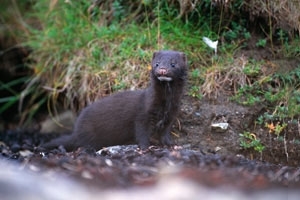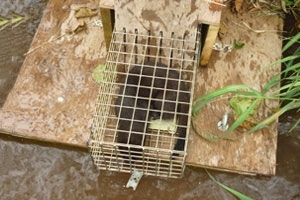 The mink we have in Britain are not native here. They are American mink (Neovison vison), which originated from mink brought here for fur-farming.
The mink we have in Britain are not native here. They are American mink (Neovison vison), which originated from mink brought here for fur-farming.
In continental Europe, there is also a European mink (Mustela lutreola), a somewhat different species and now endangered. The European mink has apparently never existed in the British Isles.
A widespread modern misconception is that the UK’s wild population of American mink originated from mass releases of mink from fur farms by animal rights activists in the 1990s. Many people will remember these dramatic events for the sheer numbers of mink involved. In fact, the wild population was established decades earlier from multiple escapes (and perhaps deliberate releases) all over the country.
Mink farms in the UK
Mink farms had been established in the UK from the 1920s, and expansion of the industry resumed after WWII. At its peak in the 1950s, there were 400 known fur farms in the UK, and there were suspected to be additional ‘backyard’ units. Mink were first confirmed to be breeding in the wild in 1956. By December 1967, wild mink were present in over half the counties of England and Wales, and in much of lowland Scotland.
Government reaction to the proven establishment of mink in the wild was indecisive, costing valuable time. (The period spanned Conservative governments 1951-64; Labour 1964-1970; Conservative 1970-74.) It was not clear that there was a self-sustaining wild population, though since Norway had already been comprehensively settled by mink, it seemed inevitable. No serious damage to agriculture or fisheries had been shown, and MAFF held no particular responsibility for the environment.
The term biodiversity had not even been conceived. The Treasury was reluctant to commit money to a process of undetermined feasibility and duration, where the moral responsibility appeared to lie with the fur industry. It was not until 1964 that a MAFF mink eradication team of seven people was funded, and it was wound up in 1970 when it was clear that this level of commitment was inadequate.
Attacks on mink farms
The fur farming industry in the UK was subject to increasing statutory restrictions from 1975 until it was finally banned completely by the Fur Farming (Prohibition) Act 2000. The few fur-farms still operating at that time had been the focus of attacks by animal rights activists.
By now, the mink kept in fur-farms were very different from those of the 1920s, having been selected over many generations for ease of handling and in effect domesticated. Consequently many of the mink released in the attacks of the 1990s were quickly recaught and the remainder probably contributed little to the wild mink population.
 A GWCT survey through the summer and autumn of 2002 on the upper River Avon, close to one of the farms targeted (twice) by activists at Ringwood, found that mink were present at only 50% of sample sites.
A GWCT survey through the summer and autumn of 2002 on the upper River Avon, close to one of the farms targeted (twice) by activists at Ringwood, found that mink were present at only 50% of sample sites.
One of the fascinating things about mink feralised from fur-farm stock is how quickly they have reverted to the chocolate-brown ‘wild-type’ colouration – within a few decades. Back in the 1960s, according to MAFF operators, the colours of wild-caught mink in the UK reflected the specialities of nearby fur-farms.
Colonisation of Britain is probably still ongoing: areas in the extreme north of Scotland appear not to have mink yet. Now that the mink is established, it raises awkward issues shared with a long list of other introduced species. The problem of how to deal with invasive introduced species is substantial, and strategic thinking is still in its infancy (see NNSS website).
How best to manage mink?
So as yet there is no official national strategy for managing mink, although the main interest groups – under the leadership of the GWCT - are collaborating to create one. Fundamental questions include ‘How much control of mink numbers is needed to preserve biodiversity?’ and ‘How much control is possible, and what does it cost?’
So as yet there is no official national strategy for managing mink. Some very large regional projects have developed in Britain and in other European countries, following a variety of different models for resourcing the work.
Almost all now use the GWCT mink raft as a standard tool. Fundamental questions no longer include ‘Is it possible?’ but are now more commonly ‘How much control can we afford?’ and ‘Is the situation achieved through mink trapping tenable in the long term given available resources?’.
Projects that depend heavily on external funding during the early stages inevitably run into a funding crisis later on. Arguably the most sustainable model is one where the resources come from within the region itself, e.g. through community effort; but there is also a strong case to seek special funding for the high initial costs from national or EU sources.
Get the Latest News & Advice
Join over 100,000 subscribers and stay updated on our latest advice, research, news and offers.
*You may change your mind any time. For more information, see our Privacy Policy.